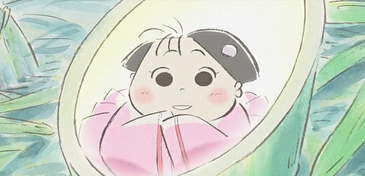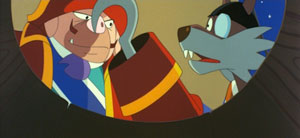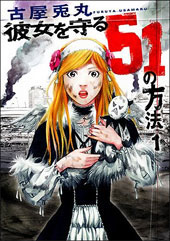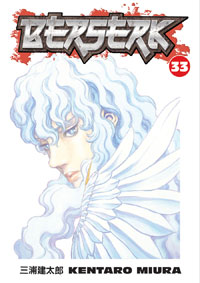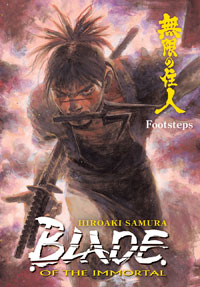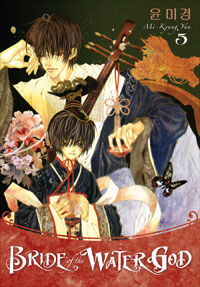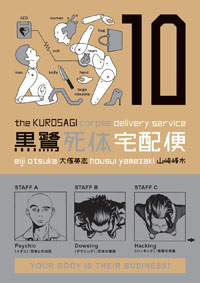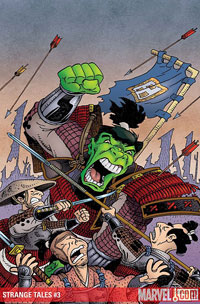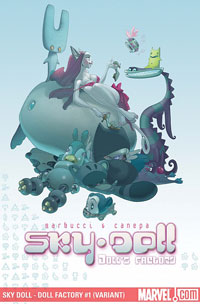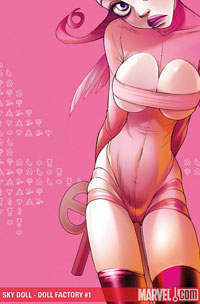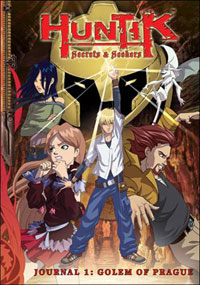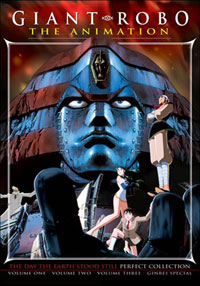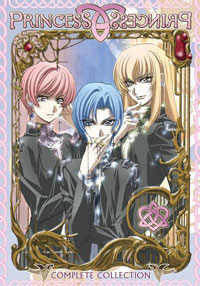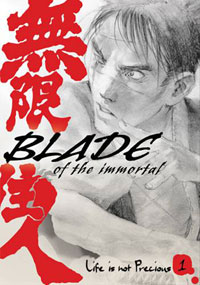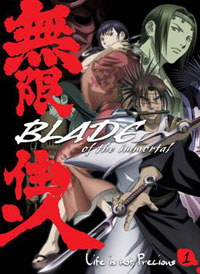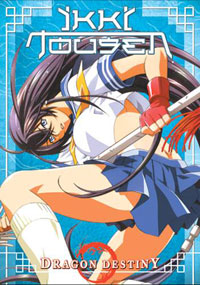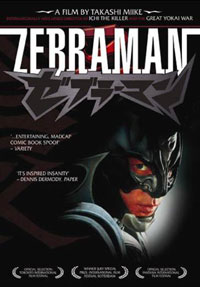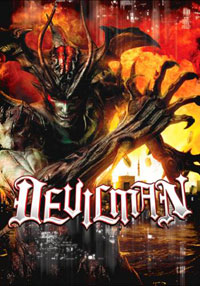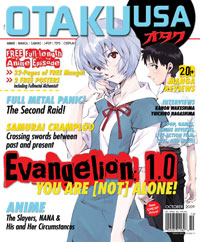 Logo handmade by Bannister
Column by Scott Green
Logo handmade by Bannister
Column by Scott Green
AICN Anime - Pop Genius Junko Mizuno Shares Her Thoughts on Mischievous Fairytale Little Fluffy Gigolo PELU
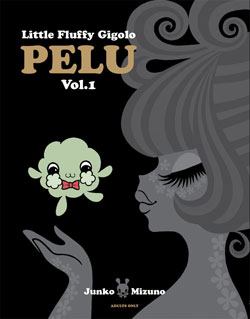
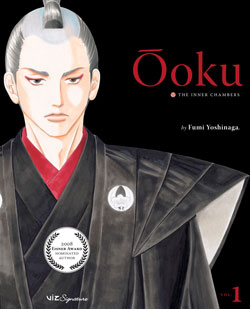
Manga Spotlight: Ooku: The Inner Chambers Volume 1 by Fumi Yoshinaga Released by VIZ Media
Based on the anticipation, the admiration for Fumi Yoshinaga's Antique Bakery, and based on the quality of the work, I'm confident that Ooku will be a contender for the most praised manga release of the season, and I wouldn't be shocked if it's the overwhelming favorite. While I don't anticipate the kind of non-specialty notice that Yoshihiro Tatsumi's A Drifting Life received, I expect glowing praise to illuminate the online manga discourse at least into the fall. Presuming that I'm correct, and presuming that the reviews look how I think they're going to look, I'm not going to disagree with them. It didn't take me long to recognize Ooku as the kind of work that I can intellectually appreciate, but which leaves me cold. Farewell My Concubine, A Tale of Two Sisters, Ooku.. these are works that I'll insist I "got," but which didn't effect me. I'd like to think that the dispassionate reaction isn't a matter of genre. Ooku runs in the anthology Melody, which is considered a josei magazine (I think the only other Melody manga published in North America is Gaccha Gacha from Tokyopop). Josei is a genre for young women in their upper teens, into adulthood. I'd point to Moyoco Anno's Happy Mania and say that I'm a fan of the genre, but my taste veer towards the down and dirty, relationships between individuals trying to be adults. The smart and sensible Ooku captured my attention on a cold, analytical level. In an emotional respect, I wasn't inclined to meet it half way. Ooku speculates from an alternative course of history. The manga opens with a fatal mishap in a small village. The episode seems like it would have been a memorable experience that would mark life in an agrarian community, but given what happens in its wake, the event takes on symbolic, near religious significance. That village becomes the home of the patient zero in a Redface Pox epidemic that will kill off the majority of Japan's male population. 80 years later, Japan's male population is one quarter the count of its female. Consequently, from laborers to leaders, women have become the primary agents of the society while men have largely become a commodity for their reproductive value. The historic Ooku was the residence of the female members of the shogun's retinue, including his family and concubines. The political intrigue generated by this separate world of women who could not leave of their own will and could not see men outside the presence of the shogun has been reflected in a few of the anime/manga released in North America. For example, it was an element of the succession conflict behind the ninja death match captured in the story that's been titled The Kouga Ninja Scrolls, Basilisk, or Shinobi: Heart Under Blade across its various media presentations. Fumi Yoshinaga's Ooku is a harem of beautiful men, reputed to number in the thousands, closed off and sworn to absolute secrecy. None of this is as salacious or as titillating as it might sound, as Yoshinaga is more concerned with sussing out the distinctions between form and function and examining the humanity of her subjects than any sort of spectacle. After that village mishap introduces Ooku's conceit, the manga skips ahead the better part of a century and settles on a new focus. Hiroyuki Mizuno conforms to the standards of a romantic hero. With a love of fencing, he's a relic of a lost age. He's also the son of family with noble lineage (that stretches the point a bit; he's a Hatamoto rank samurai) and no money. For the trifecta, he has a long time paramour whose family finances would not raise Mizuno's to a point where they could afford to find a spouse for his sister. Rather than accept being married off, Mizuno utilizes a family connection to find a position in the Ooku. Through some adept political jiu jitsu, Mizuno is able to crank his way up the ranks of the inner society... perhaps outsmarting himself in the process. An essential aspect of Mizuno's and Ooku's mature perspective is the willingness to face reality. Specifically, Mizuno mediates his goals. Rather than betray his love, he embraces a circuitous route that allows him to provide for his family while maintaining his values. The character and his handling by the manga exhibit both intelligence and sentiment. Even my stone heart was moved a bit as Mizuno faces what he needs to do without being able to forget his attachments. The other key figure of the volume is 8th Tokugawa shogun Yoshimune. This is the zenith of the hierarchical society, and, in theory, the Ooku exists for her benefit. Like Mizuno, Yoshimune operates from a realistic perspective, that is never the less shaded by sentiment. As a ruler, Yoshimune is keenly aware of the essential elements of ritual, such as appearing as a gender balanced populous to foreign visitors. At the same time, she's looking to sift form from function. She's keenly aware of the depleted finances of the shogunate. With the aim of properly administering the domain, she looks to scale back and adjust unessential drains where she finds them - like in the Ooku. Both Mizuno and Yoshimune prove to be thoughtful, principled outsiders entering into a staggeringly complex world, governed by both arcane, proscribed rituals and active agendas. With these characters planning and thinking quickly to ensure that they don't loose their footing, Ooku's first volume proves to be both thoughtful and eventful. At the same time, Ooku, is a notably dialog-verbose manga, and with distinctions emphasized by use of archaic grammar, it's not a quick read. Despite the amount of speech, the manga is not overly packed with exposition. Analysis is still needed to pick up the full meaning and intention, and as such, Ooku is superlatively dense manga. While the subject, style and priorities could not be more different, in terms of requiring that the reader process a large number of ideas in a small space, I'd compare Ooku to Masamune Shirow works. Down to its planned serialization, Ooku is a distinctive work of manga. While most manga have a beginning and ending planned by the author, and a length determined by editorial and popularity dictates, Ooku is intended to convey its story across 10 volumes. Ooku is not necessarily a manga that I'll be tracking with anticipation, but it's impossible to neglect strongly recommending a manga that handles its characters this intelligently and humanly. Regardless of whether you're interested in the premise, Ooku manga that's worth reading.
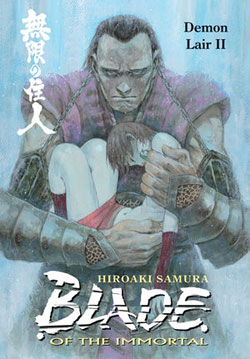
Manga Spotlight: Blade of the Immortal Volume 21: Demon Lair II By Hiroaki Samura Released by Dark Horse Manga
Excerpted from Hiroaki Samura Interview: from Quick Japan 38 (August 2001) Interviewer: About what volume do you plan to go with Mugen no Juunin (Blade of the Immortal)? Hiroaki Samura : Originally I said, "I'll end it at 5 volumes." Now that I've already done 12 I don't really know, but it's true that I want to finish it within the next 3 years. .... Interviewer: In any case you thought of it as something "new". While you can't help classifying it into a genre I suppose, as I've said I haven't seen anything like it before. Please give us your honest thoughts on this. Hiroaki Samura: It's something I wanted to do while I was still young. So then after I'd turned 30 I thought, "I'm not going to be young forever, perhaps the time is now?" So I drew Ohikkoshi. Now someone might say, "This is what you wanted?" (laughs) As for it not resembling anything else, I think almost everything I do is a mismatch from the pattern. On top of that, I didn't think I had the ability to draw a gag manga. When I asked myself if I could draw one I realized for the last 8 years I truly hadn't done anything outside of Mugen no Juunin. So when I read the letters on this new one I feel like I'm wearing work clothes and really earning my livelihood! You see, I'm really not that kind of person. Blade of the Immortal is around 24 volumes in its Japanese release, and in the midst of what's theoretically its final storyline. And, in recent years, author Hiroaki Samura seems to have been hard at work ensuring that he's not locked in and typecast as the guy playing Othello every night. He's produced an eclectic and often disturbing set of post Ohikkoshi (a collection available in North America via Dark Horse) stories, including western one-shot Emerald, quasi-Victorian social commentary Bradherley’s Coach and recently, the surreal Halcyon Lunch - featuring an appearance by refrigerator with the face of a baby and cockroach appendages. Probably for similar reasons, Blade of the Immortal has deviated from its original course. I imagine that Samura did this to keep himself interested and was allowed to do it by his editors to keep his popular manga series running years after he planned to wrap it up. If you follow mixed martial arts, you'll have heard of Anderson Silva. He's currently the UFC's middleweight (185 pound) champion, with an 11 fight win streak going back to January '06 (25 - 4 career). In his weight class, he's decisively beat all of the contenders, such that it's difficult to imagine anyone posing a legitimate threat to his championship. So, he spoke about retiring, and he's spoke about competing outside MMA in a boxing match against Roy Jones Jr. The solution, at least on a temporary basis, has been for him to take fights in the light heavyweight division (205 pounds). It was a gamble, and so far it's paid off. On August 8th, he decisively beat Forrest Griffin, a former champion and arguably one of the top five fighters in the 205 weight class. Silva's still been talking about retiring, but the possibility hasn't been as credible as it was before he began testing light heavyweight. I imagine Samura largely felt that he did what he was going to do with the chambara-samurai revenge story. This is a rather experimental artist, who been working at applying traditional artistic techniques to manga, finding new ways to mix in modern and unorthodox sensibilities, and doing it since 1993. It does not seem like he'd relish producing more of the same until Blade of the Immortal's fans were satiated and the manga's popularity was exhausted. The gamble that Samura took wasn't so much along the lines of a 185 to 205 vertical jump as it was a lateral one. He locked down the manga. He took its strong sword arm and bound it. Since volume 16, Samura has been exploring the depths of the capacity for dehumanization, with the active hero and a stock of disappeared criminal serving as test subjects locked in the cells below Edo Castle. With Blade of the Immortal evoking uncomfortable subjects, such as World War II history concerning the Imperial Japanese Army medical research project Unit 731, Samura has literally hamstrung the manga's capacity to deliver on genre action. And, it's been on this "Prison Arc" longer than it dwelt on the hunt down the exotic foe and kill him in a spectacular fashion stories that originally constituted a large part of Blade of the Immortal's appeal. If you follow anime, you're probably aware of a more recent contender for the most alienating experiment in a popular work. Haruhi Surumiya is a light novel based dramady concerning a circle of friends constructed around the eponymous girl who only expresses interest in "ESPers, time travelers, and aliens." When Kyoto Animation first adapted it, I said Haruhi was THE anime for the anime fan. It was keyed to getting self-indentified fans excited and thinking about the series. It could intelligently poke fun at conventions of anime without being an outright parody; it could indulge in those conventions without being hypocritical. The philosophy presented might not have been on par with something like Ghost in the Shell, but it was appropriate, and the series was reliably adept at throwing out intriguing suggestions and letting the fans debate. In its second season, Kyoto Animation took their hit and proceeded to adapt the prose story "Endless Eight." The short story in question saw Haruhi enjoying her summer break so much, that it was caused to repeat on loop 15,498 times. To capture that in anime, KyoAni opted to repeat an episode of anime eight times with minor variations distinguishing each iteration. Blade of the Immortal's "Prison Arc" has been called tryingly long and less exciting than might be desired. For a bit of perspective, unlike "Endless Eight," it's never been called a prank or a "troll job." Volume 21 - Demon Lair II closes out this Edo Castle medical experiment/experimental phase of Blade of the Immortal, and in doing so it deliberately reintegrates what could be called the elements of Blade of the Immortal-Classic. The objective of the manga was once to assassinate iconoclastic sword school leader Kagehisa Anotsu in revenge for his murderous destruction of the Asano dojo. He's back. As are some other surprising figures. In an interesting approach to reintroducing the characters, Samura re-arranges and re-uses panels from a character's earlier appearance to form a background montage. In another graphical note, "death mural" elaborate splash pages capturing the terminal end to a hard fought battle, also make a return appearance. Demon's Lair's finale might feature the return of the death mural and abundant armed combat, but it could hardly be thought of as Samura relenting. This is what he's built to, in keeping with the long term sentiments of the manga. More than the chief swordsman being unchained, the end of this story marks the victory of an antiestablishment uprising in which women and disenfranchised minorities smash the product of unrestrained authority. As the wives and mothers of the disappeared riot at the gates of the castle above, the manga's protagonists cross blades with a literal Frankenstein's monster produced by governmental ambition and science amuck without moral guidance. Blade of the Immortal's premise is that its hero is a scarred, one eyed swordsman who was tricked into ingesting sacred blood worms that gave him the ability to heal almost any wound. More skilled than most, but less skilled than many of his adversaries, most battles saw him ripped up, even torn to pieces before his unique fortitude gave him the opportunity to turn the tide on his foe. Consequently, Blade of the Immortal was never clean and rarely heroic. In keeping, the victory that caps off Demon's Lair is harly glorious. Westerns, and spaghetti westerns in particular, are apt to feature dusty subjects. Kenneth Branagh's Battle of Agincourt comes to mind for a battle in which the actors are an absolute mess. As does the climax of the Seven Samurai. Manga has had its fair share of bloodied, torn up combatants, but I can't think of any where the subjects are as filthy as Demon Lair's, or an artist who'd be as capable as Samura at rendering it. Battling in a flooded cave, where some have been locked away, it's not just the standard design model with some splashes of blood. They're wet, disheveled, and bloodied. In this way, Samura ensures that his battle looks like raw business rather than anything heroic. The personality of this volume matches that muck covered look and demonstrates how Samura is as talented with characters as he is with pens, pencils and charcoals. The dark irreverence is outstanding. The doctor who performed the medical experiments of the story runs through the flooded caves looking for a savior, and stops at a cell... "Two Itto-Ryu Kenshi are running amok in the cell block. You three take them down! Show me your stuff!" "Itto-ryu?! are you nuts!?" "That's no deal!" "Go, die, he tells us..." "You can win! look at you! Hei-54: cut up a man while enraged after being expelled by the Yagyu" "Kour-107: former bandit leader from Hokone" "Otsu-19 ex-Kanjo Gata, took bribes for doctoring Daimyo rice records" "I'm just an accountant..." "Bandits aren't good at hand-to-hand.." "I was only a Yagyu for six months..." The combatants who actually make it into the fight include famous shogun's executioner Yamada Asaemon portrayed as a home remedy obsessed oompa loompa, our immortal samurai with one arm still chained to the wall, and an above six foot tall hulk who settles matters in a manner similar to the climax of Ninja Scroll. Even when Blade of the Immortal was deeply mired in this prison section, it was the sort of provocative story that makes manga worth reading. I think that the prison business was more about Samura keeping himself engaged with Blade of the Immortal than keeping the readers engaged. That's not to say that I found it uninteresting, but I do see how it could be read as alienating. Now that Samurai's distinctive approach is refocused on the manga's more crowd pleasing elements, it is an excellent time to re-embrace Blade of the Immortal, or even given the prison section a second chance if you didn't enjoy it from an initial impression.
Dark Horse editor Philip Simon has graciously offered his thoughts on this significant Blade of the Immortal volume...
This "Prison Arc" has been a very long, extended arc for most Blade of the Immortal fans, but my hope is that readers will come to appreciate this story line, Rin's growth during this time, and Samura's handling of multiple backup characters throughout. I feel that this story arc is similar to Samura's "Road to Kaga" arc in several ways and that he accomplished much of what he did here as he did there, in terms of Rin's character growth -- though on a much larger scale in the "Prison Arc." Our designer on the trade series, Scott Cook, was just marveling at the fact that we've been "traveling through" this arc for the entire three and a half years he's been here. I'm really close to the material, though, and I've read the series multiple times through at different points, going from assistant to associate to editor -- and having this series on my plate pretty much the entire ten years that I've been here at Dark Horse makes me really fond of it. This has been the longest and strangest arc, for sure. Well, now that things have quickened, I hope you have fun reading it! The story moves really fast in this Volume 21 outing, and I love how all of Samura's different plot threads come together. Our next volume after this one is really fun, too.
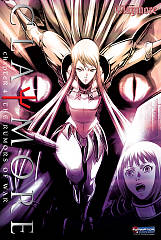
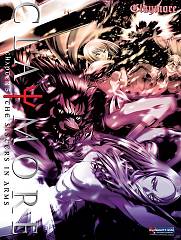
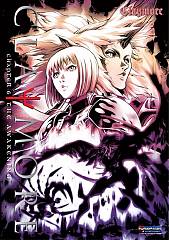
Anime Spotlight: Claymore Chapter 4: The Rumors of War Chapter 5: The Sisters in Arms Chapter 6: The Awakening Released by FUNimation
While I don't feel that my early reticence towards embracing Claymore was unfounded, after the series coalesced midway through, I actually found myself engaged by its characters and fantasy. These days, anime is not producing many works that are evocative of the Western fantasy epic. I can list a host of manga, but in anime... Claymore, Guin Saga... Queen's Blade has some D&D underpinnings...For something like My-Otome, you really need to start stretching definitions... I don't necessarily think that this phasing out is lamentable . Well constructed titles with smart character and world development like Berserk were never in great abundance. If it's just going to be a monster slashing spectacle, let video games handle the genre. These days, the games will probably look as good as the anime, and there, the monster hunt will at least have the visceral quality of an interactive medium. At its half way point, Claymore stopped being the monster slashing quasi-horror fantasy that was just filling the niche and started developing an identity. It embraced what I call its "Daughter of Kenshiro" quality, in which its vehement adherence to shounen fighting manga conventions were mediated with shojo sentiments. It became recommendable, not just because of the scarcity of competition. A camaraderie developed between the characters that distinguished their relationship from anime's standard surrogate family dynamic. With sisters in arms caring about each other, a reason to connect with these characters was established, and as they launched into battles with the odds stacked against them, Claymore became genuinely exciting. The representative Claymore tableau that will stick with me crops up late in the series. It's on a snow swept forest north country. A contingent of silver armored blonde women are fighting, and to a large extent losing, against an onslaught of gray beast-men. On one hand, the foes are generic, rampaging semi-humans. On the other, the imagery of blonde valkery painting the snow red is provocative, not necessarily in a good way. The optics here almost constitute a challenge...sadistic, misogynous, Nazi fetishist, would-be shocking runner up to innumerable fantasy video games. Yet, Claymore does not really appear to be intent on striking those nerves. Though inspired by western aesthetics and western fantasy tropes, down to the Mount Doom climax, and though it references cultural touch stones such as Hamlet, it is divorced from the full force that its imagery might have had if it was really was rooted in the western tradition. In this case, I think that a sword wielding blonde woman slicing up a snake monster is only supposed to be signifying an attractive woman in an exciting situation. I see little evidence of deeper symbolic ambition. Claymore succeeds or fails based on its ability to deliver arresting confrontations between warrior women and a supernatural world, not based on whether its wrong headed in invoking touchy subjects. That might sound apologetic, but, I wish it was a smarter. That scene does capture an aspect of Claymore that does work in its sense of a group of women against the world. These are mission driven warriors with no alternative except to rely on each other. The men who govern their actions are duplicitous. The populous treats them as a necessary evil or a reviled threat, depending on whether there's a demon salivating on their doorsteps. Once the series moves beyond its initial phase, in which one of these women is humanized by adopting a little brother surrogate who wishes he could protect her, these women begin working together and the anime gets interesting. What the manga does with that cadre of women couldn't be closer to the shonen standards if the chief heroine was Goku in a skirt, but the way in which it escalates threats and abilities is still involving. The latter part of the series goes from a suicide mission, to an ad hoc skirmish against an entrenched, overwhelmingly powerful foe to an expedition force of the women against an invasion army of monsters. These later engagements also do Claymore the favor of partitioning the conflict off into remote areas. It's been my contention that the quasi-medieval society of Claymore is distractingly dysfunctional. At least it should be. It's plagued by monsters who can adopt the form of humans and consume whole families in a night. It's not the lone vampire in the boondocks scenario. These fiends are pervasive and given to attacking large cities. As such, it seems like all local, not to mention inter-community trust should have broken down. It shouldn't be Ye Olde quasi-Europe with monsters and hunters chasing each other. From what I read about the manga, this is ultimately explained, but... first, that doesn't help the anime. second, from what I gather, it an "everything you knew was wrong" revelation. Moving the fighting into remote forests, ruins and frontiers allows this to be ignored. Dramatically this works in having the heroines fight desperate conflicts far from where anyone would know if they lived or died. The heroes' escalating abilities is also baked into the premise of Claymore, but in a consciously twisted manner. While not strictly unique, it does work for the anime. The more the heroines use their abilities to fight their monstrous foes, the more they risk becoming monsters themselves. Given that most chose to become warriors to avenge the deaths of family at the hands of the foes, it's meant to be a gut-wrenchingly tragic prospect. The successful use of this facet is not consistent. Sometimes it's overly obvious, expressed in platitudes. Other times, it is striking to watch the women try to hold onto their humanity while struggling to overcome a powerful foe in mortal combat. The interesting aesthetic rejoinder is that this transformation disfigures the anim's attractive leads. The appeal of the anime owes much to watching attractive women in exciting battles, but as the battles become more heated, the woman often become more monstrous. The Claymore anime's ending has proven to be a controversial topic among fans of the original manga. I haven't read the manga beyond the first volume and have no allegiance to the original form, but I do know that with the manga ongoing, the anime hit the not-uncommon problem of needing to put together an original ending to lend the work some sense of closure. I could've hoped for something gutsier... either more open ended like Berserk or more original in its conclusion like Full Metal Alchemist. Instead, (spoilers) it teases a fight with the Raoh figure/ultimate antagonist in a way liable to displease viewers regardless of whether they've read the manga or not. In most respects, Claymore is an anime that is an engaging spectacle that isn't quite as smart as it could have been. The animation for example... It's snowing throughout most of the final story line, and that is a perfect mood setting effect. When the foes meet action is fast, and with sword on tooth and claw clashes, quite kinetic. At the same time, there are propensities for receptiveness and short cuts. It's not unusual to see a ricochet repeated. Too many times, foes become locked in a contest of strength with one pushing up, while another pushes down... often on of the contestants is a monster, pushing with one claw, while the other potentially decisive appendage simply idles. I don't think it's saying much to call Claymore one of the best fantasy anime in years, but I do still think it is one. It's not as good as it could have been, but it is good enough.
Ponyo, Miyaki and Ghibli
Because I lost a week, some of this is a bit old... Deb Aoki rounds up Ponyo impressions Kai-Ming Cha rounds up all things Miyazaki Even if you're exhausted by Ponyo talk, read AniPages Daily's piece AP says Animated `Ponyo' is beautiful nonsense From there, the pieces feel a bit scattered. Mom feels compelled to leave her son and the fish-girl home alone while she battles rain, winds and flooded roads to get back to the senior center where she works: "You're only 5 but you're very smart," she tells Sosuke. Could she be the most neglectful mother ever? Tasha Robinson on Ponyo at AV Club While the story is modeled on a traditional fairy tale and a traditional love story, it’s more primal than it looks. In keeping with Miyazaki’s usual motifs, Ponyo’s attachment to Sosuke is an unthinking force, as avid and single-minded as the decapitated forest spirit in Princess Mononoke, or the crazed, murderous Ohmu in Miyazaki’s Nausicaä Of The Valley Of The Wind. Underwire Simple Artistry Trumps CGI in Miyazaki’s Ponyo Ponyo’s innocent transgression knocks the natural order of things out of balance in the sleepy seaside village she once lived beneath. But unlike the War on Terra of Miyazaki’s previous films Princess Mononoke and Nausicaä of the Valley of the Wind, the Academy Award-winning director has lightened his audience’s load by keeping the environmental activism of Ponyo to a minimum. Instead, he keeps the proceedings lighthearted and uses his paintbrushes to revel in the planet’s pulsating possibility. The Otaku Ohana blog on Ponyo's box office performance in its premiere weekend NY Times reviews Ponyo On a list of per-theatre earningsThe Beat on the topic In its second week it fropped from 9 to 13. It earned a little under $2.5 million and has accumulated just above $8.1 million. AWN spoke to longtime Studio Ghibli animator Katsuya Kondo On NPR Ponyo: A Role Model For Kids With Autism? Family 411 on the flick Tim Maughan on the film Otaku USA look at Miyaki's Berkeley appearence - more on the appearence here LA Weekly on Hayao Miyazaki On Ponyo A Catholic view on Ponyo LA Times on color designer Michiyo Yasuda orn in Tokyo in 1939, Yasuda joined the ink-and-paint section of the company Toei Doga -- now Toei Animation -- before she was 20. After honing her craft working on commercials and television series, she met animation legends Isao Takahata and Hayao Miyazaki and joined them on the production of 1968's "Little Norse Prince." "Mr. Miyazaki and I were on the staff of the same film during my time working at Toei Doga," Yasuda says. "As a color designer, I have worked with Mr. Miyazaki since the 1976 television series '3000 Leagues in Search of Mother.' I have respected Mr. Miyazaki since our days at Toei Doga, and I have always loved his way of thinking." Since then, she has dedicated her career to creating color designs for both Takahata and Miyazaki on films, including 1978's "Future Boy Conan," 1984's "Nausicaä of the Valley of the Wind," 2001's "Spirited Away," 2004's "Howl's Moving Castle" and Miyazaki's latest film, "Ponyo," the story of a goldfish who wishes to become a little girl. Reuters - Japanese director Miyazaki seeks breakout U.S. film Yahoo's Miyaki 101 feature KPBS on the film Hayao Miyazaki insists that Ponyo's Sosuke is not based on his son Goro The artist formerly known as Moriarty on his Ponyo screening Anime News Network's topical podcast Helen McCarthy's (Anime Encyclopedia) Caging the Mermaids: Ponyo’s Older Sisters As Jonathan Clements and I observe in The Anime Encyclopedia, the film (Howl's Moving Cast) was a love letter to Miyazaki’s wife Akemi Ota, who gave up her own career to raise his children and create a home in which the workaholic spent very little time. The final shot shows Sophie in the arms of her wizard, the centre of his world, accepting it as her own. Ponyo has been given extra layers of significance by the assertion that boy hero Sosuke is based on Miyazaki’s son Goro, whose directorial debut at Studio Ghibli was attended by widely hyped tales of a father-son feud. Is the heroine merely a cipher inserted for the hero to play off, a magical girl for him to tame and bring into the human world? I don’t know yet, but I’m looking forward to finding out. Screen Daily on distributing Miyazaki films Ghibli may be flexible when it comes to translating the dialogue but it has a strict policy forbidding distributors to edit the film itself, which originated when Miyazaki’s 1984 classic Nausicaa Of The Valley Of The Wind was dramatically recut for US release as Warriors Of The Wind. Indeed when Harvey Weinstein suggested cuts to Princess Mononoke for Miramax’s 1999 US release, he was given a categorical no. Ponyo Toy Chases Ham in Your Tub
- Spirited Away (limited release, Sept. 20-22, 2002): $17,301 (26 screens)
- Cowboy Bebop: The Movie (April 4-6, 2003): $12,338 (19 screens)
- Howl’s Moving Castle (June 10–12, 2005): $11,888 (36 screens)
- Pokemon: The First Movie (Nov. 10-12, 1999): $10,199 (3,043 screens)
- Pokemon The Movie 2000 (July 21-23, 2000): $7,113 (2,752 screens)
- Ghost in the Shell 2: Innocence (Sept. 17–19, 2004): $6,760 (47 screens)
- Blood: The Last Vampire (July 10-12, 2009): $5,501 (20 screens)
- Street Fighter: The Legend of Chun-Li (Feb. 27–March 1, 2009): $4,156 (1,136 screens)
- Yu-Gi-Oh! The Movie (Aug. 13–15, 2004): $3,934 (2,411 screens)
- Ponyo (Aug. 14-16, 2009): $3,868 (927 screens)
- Steamboy (March 18–20, 2005): $3,490 (39 screens)
- Pokemon 3 (April 6-8, 2001): $3,080 (2,675 screens)
- Pokemon 4Ever (Oct. 11-13, 2002): $2,879 (249 screens)
- Spirited Away (post-Oscar wide release, March 28-30, 2003): $2,483 (711 screens)
- Digimon: The Movie (Oct. 6-8, 2000): $2,322 (1,823 screens)
- Dragonball Evolution (April 10-12, 2009): $2,181 (2,181 screens)
- Appleseed (Jan. 14-16, 2005): $2,157 (31 screens)
- Pokemon Heroes (May 16-18, 2003): $1,328 (196 screens)
Ponyo icons Ghibli World reports that Ghibli co-founder Isao Takahata's first movie his water color style adaptation of family comic strip My Neighbors the Yamadas will be a retelling of 10th century Japanese folktale Taketori Monogatari (The Tale of the Bamboo Cutter) From Ghibli World Taketori Monogatari is considered to be Japan's oldest extant narrative and tells the story about the life of a mysterious girl called Kaguya-hime. Discovered as a baby inside the stalk of a glowing bamboo plant (note: a similar scene interestingly also appears in Takahata's My Neighbors the Yamadas), she is said to be from Tsuki-no-Miyako (The Capital of the Moon) and has unusual hair that "shines like gold". a summary of the Tale of the Bamboo Cutter An overview of the work of Isao Takahata Ghibli Museam photos Reverse Thieves on early Miyazaki Animal Treasure Island Mono no aware on early Miyazaki/Ghibli movie Castle in the Sky Cartoon Brew on Yasuji Mori and Hayao Miyazaki AniPages Daily on Miyazaki on influencial animator Yoshinori Kanada
Astro Boy News
The full Astro Boy trailer 23-year-old actress Aya Ueto has been cast as the Japanese voice of Astro Boy (aka Atom) while Koji Yakusho (Tokyo Sonata) has been cast as father/creator Doctor Tenma. The English language cast includes Nicolas Cage, Kristen Bell, Donald Sutherland, Nathan Lane, Bill Nighy, Eugene Levy, Matt Lucas and Freddie Highmore. USA Today has a preview of the IDW comic adaptation Astro Boy makes a Cracked list Project Atom wallpapers Astro Boy crew tee Astro Boy Hush Puppies* Siliconera reports that the adaptation of the Imagi Astro Boy will ship on three platforms in North America, the PSP, Wii, and a DS adaptation not handled by High Voltage. Only the PSP version is heading to Japan Rains confirmed that only the PSP version is heading to Japan. A game video
Going Hollywood
Maggie Q (Mission: Impossible III, Live Free or Die Hard, upcoming King of Fighters) has been cast in the Scott Stewart adaptation of Korean horror western Priest. Karl Urban was cast as the vampire villian. Additional casting announcements include Stephen Moyer (True Blood) and Lily Collins (90210) Paul Bettany and Cam Gigandet have also been cast.* Anime News Network reports Battle Angel Alita producer Northrop Davis confirmed at the Saturday grand opening of the New People cultural entertainment center in San Francisco that he pitched the Berserk, Baki The Grappler, and Barefoot Gen manga to studios in Hollywood. To a question posed by panel moderator Patrick Macias about projects that Davis has developed or is currently developing, Davis responded with the following: We were involved with [Kentarou Miura's fantasy adventure story] Berserk, and it almost happened, but that is not quite there. Train Man has been a very [long] two-year, ongoing negotiation — very complicated. Phil Rosenthal, who created [the American television series] Everybody Loves Raymond, wants to remake the show in the United States. Phil wants to really adhere to the wonderful work that the Japanese creators did on that. And, also, we're involved in [Keisuke Itagaki's fighting tournament story] Grappler Baki. And one that is really close to our hearts is Barefoot Gen. We're really, really trying to find someone to make Barefoot Gen because we feel that it is incredibly important to bring the message that that conveys to the world. [Creator Keiji] Nakazawa has given us permission to work on that. For those of you who don't know, that's the atomic bomb project, where [the author] was in the atomic bomb fallout, survived it, and went on to create a wonderful series. If you've never seen it, you should read it. On Twitter Ed Chavez notes Guin Saga, MW, Ode to Kirihito and Summer of the Ubume have been pitched recently as well
Upcoming in North America
War of the Worlds: Goliath mecha versus World of the War martians trailer Bandai Entertainment The Robert's Anime Corner Store blog notes that November Bandai releases include Gundam 00 , Vol #3 DVD (Eps #18-26) Gundam 00 , Vol #3 DVD Special Edition (Eps #18-26) Hayate the Combat Butler DVD Bundle #3 (2 Disks) (Eps #15-21) In addition to Bandai's new release announcements, they have also delayed four releases: Ghost Slayers Part #3 DVD Bundle (Eps #21-30) - bumped from Sep 1 to Sep 15 Sola Complete Collection DVD Boxed Set (Eps #1-13 + 2 OVA's) (Anime Legends) - bumped from Sep 15 to Sep 29 Gundam 00 , Vol #2 DVD (Eps #10-17) - bumped from Sep 15 to Sep 29 Gundam 00 , Vol #2 DVD Special Edition (Eps #10-17) - bumped from Sep 15 to Sep 29 CMX Deb Aoki took a look at 5 CMX Titles to be released in 201051 Ways to Save Her by Usamaru Furuya - September 2010 (the San Diego Comic Con announcement that excited me most) Nyankoi! by Sato Fujiwara - July 2010 The Phantom Guesthouse by Nari Kusakawa - July 2010 Shissho Holiday by Otsuichi and Hiro Kiyohara - July 2010 Tableau Gate by Rika Suzuki - August 2010 Dark Horse BERSERK VOLUME 33 Kentaro Miura (W/A) On sale Jan 27 b&w, 232 pages $14.95 TPB, 5 1/8" x 7 1/4" BLADE OF THE IMMORTAL VOLUME 22: FOOTSTEPS Hiroaki Samura (W/A) On sale Jan 13 b&w, 232 pages $19.95 TPB, 5 3/4" x 8 1/4" BLOOD+ KOWLOON NIGHTS Hirotaka Kisaragi (W/A) On sale Jan 20 b&w, 176 pages $9.95 TPB, 5" x 7" In his years as a Hong Kong police officer, Nishi Tatsuyoshi has never seen murder victims like the ones being found in the abandoned Kowloon Walled City. Bodies completely drained of blood are showing up every few nights, and rumors of vampires are swirling. The closer Nishi gets to the truth, the more obstacles are thrown in his way. Someone doesn't want him to discover what's really going on! Forced into an uneasy alliance with the Chiropteran-hunting Red Shield organization, Nishi works with a mysterious cello player named Hagi as they try to find the source of the murders and bring down the Wong family--which peddles a miracle drug they claim will give users immortality! BRIDE OF THE WATER GOD VOLUME 5 Mi-Kyung Yun (W/A) On sale Jan 13 b&w, 184 pages $9.95 TPB, 5 3/4" X 8 1/4" CHOBITS OMNIBUS EDITION CLAMP (W/A) On sale Jan 27 B&w, 720 pages $24.95 TPB, 5 1/8" x 7 1/4" Some people buy their personal computers based on style . . . and in near-future Japan, the hottest style for your "persocom" is shaped like an attractive android! Poor student Hideki, fresh off the farm and trying to get into a Tokyo university, has neither money nor a girlfriend--then finds a persocom seemingly discarded in an alley. Taking the cute robot home and activating it, Hideki finds her affectionate, but amnesiac, able only to say the word "Chi"--and so he names her. But who is this strange new persocom in his life? Instead of being his digital assistant, Hideki finds himself having to teach Chi how to get along in the everyday world, even while he and his friends try to solve the mystery of her origins. Is she one of the urban-legendary Chobits--persocoms built to have the riskiest functions of all: real emotions, and free will? GANTZ VOLUME 9 Hiroya Oku (W/A) On sale Jan 27 B&w, 232 pages $12.95 TPB, 5 1/8" x 7 1/4" THE KUROSAGI CORPSE DELIVERY SERVICE VOLUME 10 Eiji Otsuka (W) and Housui Yamazaki (A) On sale Jan 13 b&w, 216 pages $10.95 TPB, 5" x 7" Drawn & Quarterly Same Hat has learned Drawn & Quarterly will be publishing Red Kimono by Oji Suzuki on March 16, 2010 This is exciting news for gekiga fans and fits in well with their editorial direction of late; Suzuki was an original broham of the alternative manga scene, and part of the GARO 1-2-3 trio of cartoonists, alongside Shinichi Abe and Masuzou Furukawa Anime on DVD forum goers heard back from Dark Horse on release plans for volume 4 of Ghost Talker's Daydream Ghost Talker's Daydream has been a marginal title, and is basically on hiatus during this crappy economic slump. We've basically cut back to the safe bets for now. I hope we can revisit the series in the future, but given how long it takes for economic trends to correct and compensate, it might take a while if it makes it back to the schedule. Funimation 11/10/09 Tsubasa: Season One - Blu-ray 12/1/09 Gunslinger Girl: Season 1 Collection - Blu-ray - $59.98 Gunslinger Girl (OVA) - $14.98 12/15/09 Basilisk: Complete Collection - Blu-ray - $79.98 Samurai Champloo: Complete Collection - Blu-ray - $79.98 12/29/09 Blassreiter: Complete Collection, Part 2 - $59.98 Ichi: The Movie - Live-Action - $24.98 Ichi: The Movie - Blu-ray - $34.98 FUNimation Entertainment yesterday announced the first four voice actors cast in the upcoming anime series Soul Eater: Death the Kid - Todd Haberkorn Liz - Jamie Marchi Patty - Cherami Leigh Death Scythe - Vic Mignogna About Soul Eater Unapologetically surreal and action-packed, Soul Eater is the tale of living weapons who team with human masters to hunt evil souls. Only after these dark forces are consumed can these partners hope to join the ranks of the famed Death Scythes. Maka and her weapon, Soul, are among the new students at a university run by Death himself. As they learn the ways of collecting souls, this fresh class of reapers must work together to keep witches, werewolves, and zombies from unleashing evil upon the world. FUNimation Entertainment will release the series in four half-season sets beginning in early 2010. From Robert's Anime Corner Store The MSRP on the upcoming El Cazador de la Bruja Part #1 DVD Box (Item # FN-09870) from $59.98 to $49.98 - Samurai 7 BluRay DVD Box from $99.98 to $69.98 - Full Metal Panic 2nd RAID BluRay DVD Box from $99.98 to $69.98 - DragonBall Z Season 5 DVD Boxed Set (Eps #140-165) (Re-Mastered)from $49.98 to $34.98 - 009-1 Complete Collection DVD Boxed Set (Eps #1-12 + Bonus Ep) from $49.98 to $29.98 Marvel Not manga, but of note... Strange Tales #3 (of 3) Written by Peter Bagge, Max Cannon, Chris Chua, Becky Cloonan, Nicholas Gurewitch, Paul Hornschemeier, Jonathan Jay Lee, Corey Lewis, Stan Sakai, Jay Stepehens & More! Art By Peter Bagge, Max Cannon, Chris Chua, Becky Cloonan, Nicholas Gurewitch, Paul Hornschemeier, Jonathan Jay Lee, Corey Lewis, Stan Sakai, Jay Stepehens & More! Cover by Stan Sakai You won’t believe your senses!!! Marvel is proud to present the final issue of this hotly anticipated three issue anthology showcasing Marvel’s greatest characters re-imagined by the best and brightest talents working in independent comics today. Don’t miss what’s sure to be one of the most exciting collections of comics short stories ever produced!!! Every issue stars a stunning array of the best, most exciting cartoonists on the planet—showcasing the Marvel Heroes as you’ve never seen them before! Featuring the long-awaited Peter Bagge “Incorrigible Hulk” serialized over all three issues! 48 PGS./Explicit Content ...$4.99 Sky Doll – Doll’S Factory #1 (Of 2) Written by Barbara Canepa Adapted by C.B. Cebulski Pencils & Cover by Alessandro Barbuci Exclusive US Variant by Claire Wendling Fans and true believers, rejoice! An awesome treasure chest is finally at your disposal, filled to the brim with drafts, sketches, roughs, illustrations and all the painstakingly collected research material which allowed Barbuci and Canepa to raise the Space Fantasy saga to an all new level. Creating their own blend of drama and fun, mixing sci-fi and cyber culture with religious concepts and elements of design from the ‘60s, they have created a universe to dive into and delight in! So, raiders shift your gears to plunder and set your sights on the sexiest bounty in the comic book universe! Pages and pages of exclusive and previously unreleased magic can be found in this collector’s issue! Including a 10 page exclusive never before seen file on the birth of Noa! 64 PGS./Mature ...$5.99 Media Blasters 11/3/2009 MORIBITO: Guardian of the Spirit - Vol. 7 of 8, Eps. 21-23 - 1 Disc 11/10 HUNTIK: SECRETS & SEEKERS: Legacy of the Argonauts: Journal 2, Eps. 8-13 2 Discs GIANT ROBO LiteBox - Volumes 1-3, Eps. 1-7 - Contains all 7 OVA episodes of Giant Robo and 3 OVA episodes of the Ginrei Special - 4 Discs ($19.99) 11/17 PRINCESS PRINCESS - LiteBox - 3 Discs - $19.99 KUJIBIKI UNBALANCE - LiteBox - Volumes 1-3, Eps. 1-12 - 3 Discs - $29.99 11/24 BLADE OF THE IMMORTAL - Volume 2 of 6, Eps. 6-10 - 1 Disc IKKI TOUSEN DRAGON DESTINY - Romance of the Three High Schools - Volume 1, Eps. 1-4 - 1 Disc - $29.99 TEKNOMAN - LiteBox - Volumes 1-3, Eps. 1-43 - 6 Discs - $19.99 Giant Robo It is a new dawn for mankind. The Shizuma Drive has brought clean, limitless energy and launched humanity forward into an age of prosperity. But even in this Eden of technology, there lurk the shadows of envy and greed. The BF Group is one such evil force, a secret brotherhood whose only goal is to drive the world towards chaos. Protecting the peace are the Experts of Justice, a team of operatives assembled from around the globe to stop the ultimate disaster of the Eternal Night. The key to everything is the bravery of their newest member, a boy named Daisaku Kusama, and the mighty machine he commands. Episode 1 Commentary with Kappei Yamaguchi (Daisaku) & Sumi Shimamoto (Ginrei) Episode 3 Commentary with Kazuyoshi Katayama (Episode Director, Storyboards, Settings) & Akihiko Yamashita (Character Design, Animation Director, Storyboards) Episode 5 Commentary with Masamichi Amano (Composer, Arranger, Conductor) & Yota Tsuruoka (Music Coordinator, Sound Director) Last Episode Commentary with Masami Ozono (Character Design, Mechanical Settings, Animation Director), Kenji Hayama (Animation Director), Akihiko Yamashita (Character Design, Animation Director, Storyboards) & Kazuyoshi Katayama (Episode Director, Storyboards, Settings) IKKI TOUSEN DRAGON DESTINY The Romance of the Three Kingdoms continues on in modern Japan, as the rival high schools involved in the retelling of the epic saga struggle to achieve dominance. The focus begins to shift to other high schools and the interaction of their front runners. In the backdrop, the dragons of the remaining two great leaders are awakening, leading to growing mayhem. As ancient artifacts are acquired and events unfold, the battles keep raging on with enough intensity to rend flesh and clothing. The manga was released in North America by Tokyopop as Battle Vixens. A previous anime was released by Geneon, and later FUNimation. According to Robert'a Anime Corner Store, Media Blasters could not secure English language cast for the original Ikki Tousen for the Dragon Destiny dub. KUJIBIKI UNBALANCE Hapless Chihiro Enomoto's luck changes for the better (or worse, depending on how you look at it) when he is randomly chosen as a candidate for the next student council president. Unfortunately, that means he must undergo a year-long apprenticeship with the current ruling body, accomplishing one impossible, punishing task after another. With its nonstop, side-splitting, world-within-a-world hilarity, it's no wonder Kujibiki Unbalance is a favorite among the Genshiken crew. And speaking of Genshiken, each volume includes a new episode of Genshiken as a special bonus feature! Princess Princess Tooru Kouno left a sad family life to live at a prestigious all-boys boarding school. From his very first day, he feels like he's fallen into another world. The boys in his class seem to be strangely interested in his pretty-boy looks. He's shown around by Class President Sakamoto, who is mysteriously bowed to by everyone, even the upperclassmen. Tooru even catches a glimpse of an enchanting red headed Princess. A graceful blonde named Shihoudani finally reveals the school's secret. To inspire the student body, campus pretty boys are required to dress up as girls... and Tooru is on the list! TEKNOMAN The year is 2087, and humanity is about to lose its position as the dominant life form on planet Earth. An endless swarm of biomechanical beings known as the Venomoids descend from space. Earth's Space Knights are no match for the Venemoid champions, the Teknomen. When the young pilots Ringo Richards and Star Summers find a wounded stranger named Blade, humanity gains one last hope. Blade is able to transform into a Teknoman, but he has no memories and fights to protect Earth. His opponents are not only the endless alien menace, but also the other Teknomen -- who were once human, and his family and friends. Live Action 11/10/2009 ZEBRAMAN - Special Edition - 2 Discs - $24.99 11/24 Akihabara @ Deep Movie Art Of The Devil 3 DEVILMAN - Special Edition - 2 Discs - $24.99 Shout! Factory Transformers: The Complete Series will be released on October 13th, 2009 for $169.95 Shout! Factory will release Audition 2-Disc Collector’s Edition Blu-ray ($29.99; DVD has a $ 24.99) on October 6th. The set features a new high-definition master with a new 5.0 digital Soundtrack and over 75 minutes of bonus content, including all-new interviews with the cast and new audio commentary with director Takashi Miike and screenwriter Daisuke Tengan. SYNOPSIS Deceptively innocent at first, Takashi Miike’s Audition finds Shigeharu Aoyama (Ryo Ishibashi, Suicide Club, The Grudge), a middle-aged widower of many years, urged by his teenage son and his film producer friend Yasuhisa Yoshikawa (Jun Kunimura, Ichi The Killer) to get out and start dating again. To help Aoyama meet women, Yoshikawa devises a plan to hold a fake audition for a leading lady. Reluctantly agreeing, Aoyama auditions 30 young hopefuls and falls for the silent beauty of Asami (Benetton model/actress Eihi Shiina), a former ballerina with a dark past. Their courtship veers from quiet romance to psycho nightmare. Special Features Available on Blu-ray™ High-Def: Disc One: (Blu-ray) DVD Introduction with Director Takashi Miike and star Eihi Shiina Audio Commentary With Director Takashi Miike and Screenwriter Daisuke Tengan Disc Two: (DVD – Standard Definition) New Interviews With Cast Members Ryo Ishibashi, Eihi Shiina, Renji Ishibashi And Ren Osugi International Trailers Booklet Essay By Author Tom Mes (author of Agitator: The Cinema Of Takashi Miike) Standard DVD Bonus Features DISC ONE: DVD Introduction with Director Takashi Miike and star Eihi Shiina Audio Commentary with Director Takashi Miike and Screenwriter Daisuke Tengan DISC TWO: New interviews with Cast Members Ryo Ishibashi, Eihi Shiina, Renji Ishibashi and En Osugi International Trailers Booklet Essay by Tom Mes (author of Agitator: The Cinema Of Takashi Miike) Otaku USA Editor in Chief Patrick Macias previews the September/October issue of Otaku USA The fruits of a vast and shadowy conspiracy have paid off with a cover story on Evangelion 1.0, timed for the R1 release courtesy of FUNimation. New contributor Sean McCoy (he, of several Eva DVD audio commentaries) pens the main feature while Erin Finnegan, Matt Alt, and Gilles Poitras don plug suits for sidebar duty. Other crazy stuff in this issue: Daryl Surat pens the ultimate review of M.D. Geist, Joseph Luster contemplates which Dragon Ball Z movie truly is “the greatest of them all”,


